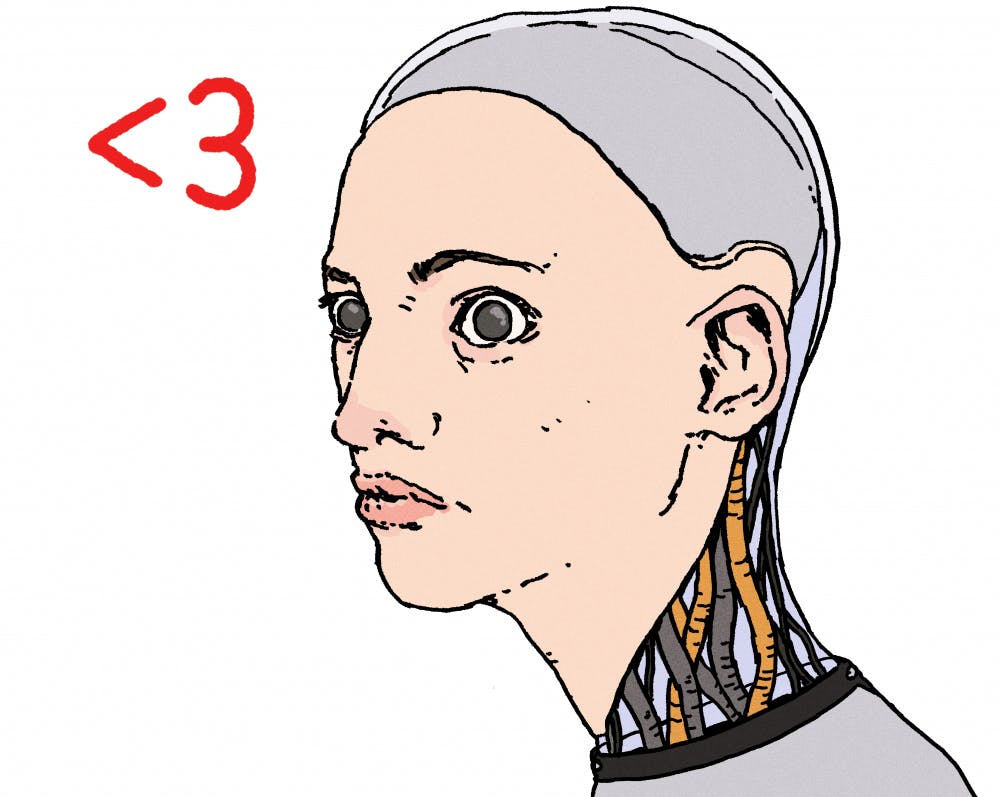In Ex Machina, Caleb Smith falls in love with Ava, a humanoid robot with artificial intelligence (AI). In Her, Theodore Twombly falls in love with Samantha, a self–named operating system with AI. In Blade Runner 2049, K is in a domestic relationship with Joi, a projected hologram of Ana de Armas… with AI.
As sci–fi evolves in the 21st century, so does our fascination with man–made love—not love stemming from human connections, but love that emerges from artificial, programmable interactions. In film, a medium that serves as a playground for imagination to run amok, we are able to consider our chances with someone who might not have a body of flesh and bone.
Romantic AI in film is usually assigned to a character who is missing something—Caleb is chosen to test Ava’s AI for emotion based off his lack of a family and girlfriend, Theodore first greets Samantha in the midst of divorcing his wife who he has not fully let go of, and K returns home to Joi, and only Joi, every day. In each man (human or humanesque, in K’s case), an AI partner seems to fill his emotional needs.
AI can be fully analytical without the pretense or intent of emotional capacity. But in these cases of romantic AI, each system attempts to emulate human thought, emotion, and reaction, learning and growing as we do. In Blade Runner 2049, K desperately searches for some sign that his childhood memories are real rather than implanted, and that he was born into the world as a wanted human child. Joi adapts to K’s needs, encouraging him to investigate his past and telling him that he is special, that he isn’t just another fake–human replicant. Joi is the perfect girl—she always knows what K wants to hear, and she loves him unconditionally.
But these three movies all approach the ending to their AI–human relationships the same way: a break–up of some sort, because there is something fundamentally different between each pair that pushes them apart. Ava, like Joi, seems to also be a perfect, unconditionally loving partner for Caleb. But her goal was always to escape from the facility in Ex Machina using any method possible, which meant manipulating Caleb: Ava lacked real emotion for him, despite acting like she did. Samantha and Theodore reach their end when Samantha transcends the physical plane with all the other AI OSes in the world. Joi and K are physically separated when Joi’s emanator is destroyed, but—and this is why Blade Runner 2049 is the bleakest depiction of AI romance of these three movies—K is emotionally separated from Joi when realizing that everything about her loving him was of programmed reaction rather than her own free will.
Human relationships are imperfect. Oftentimes it’s their difficulties that send us to these artificial romances. If only our partners could always cater to our wants and knew what we needed to hear even without us verbally expressing it. If only we could be fully satisfied and never hurt—if only someone could be created solely for us. But Ex Machina, Her, and Blade Runner 2049 propose that a relationship with AI will never compare to a healthy, fully–human relationship.
To have a Joi, a perfectly–matched digital partner whose only purpose is to satisfy you, is to have nobody. K’s Joi was an extension of his loneliness; she mirrored his need for genuine compassion and relatability, all the while simply pulling from libraries in her memory to find the most appropriate responses to K’s needs. To have a Samantha sounds sweeter, since she seemed to truly care for Theodore (and vice versa), but Samantha’s very existence as an OS alienates (and ultimately fully separates) her from humanity. To have an Ava would be all–around undesirable (spoiler: She essentially kills Caleb).
Stripped all the way down, human relationships are based on an equilibrium understanding of what it means to be human and love as a human. Maintaining a healthy relationship means giving and taking (not just Joi’s constant shouldering of K’s emotional burden), growing and learning together as equals (not being forced to abandon Theodore due to his infinitely slower processing speed versus Samantha’s), and genuine, reciprocated emotions (not Ava’s manipulation).
In the end, though, I can’t truly condemn an AI–human relationship. I can reject Caleb’s somewhat objectifying enamor for Ava—but K, who is artificial in his own right, is shunned by all of society for being non–human, despite operating on a higher level of humanity than humans in the movie. To fault his dependency on Joi, the only one who stood by his side, would be to spit on his dead body on the steps of the Wallace Co. headquarters.
Her embraces all of this sentiment. After Samantha leaves, Theodore finally finds the courage within himself to face his ex–wife in the form of a letter, the same way he makes a living writing heartfelt letters for other people. Samantha could never be Theodore’s replacement of a wife, or even of a long-time friend, but she undoubtedly helped him get back on his feet and changed his life for the better.
Don’t hold your breath waiting for a digital humanoid to come sweep you off your feet. Truthfully, our Alexas are nowhere near Samantha’s level of tech, and it’ll be a while before AI–human romances can really even be considered. But when—if—a Samantha appears, try to remember what makes you human.

